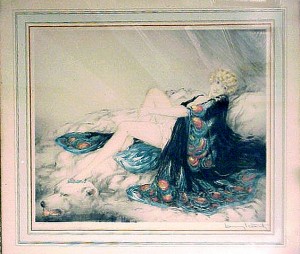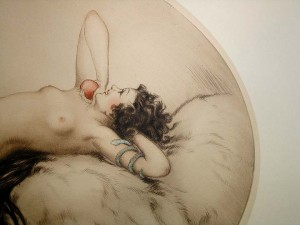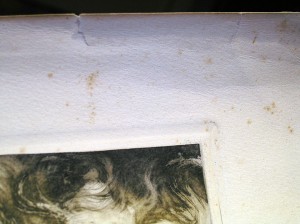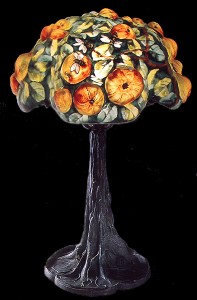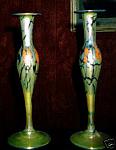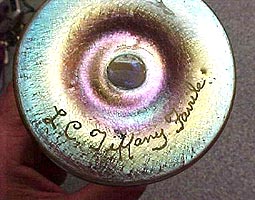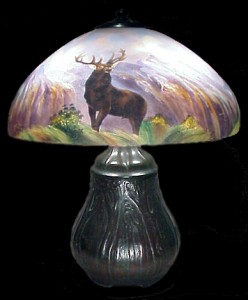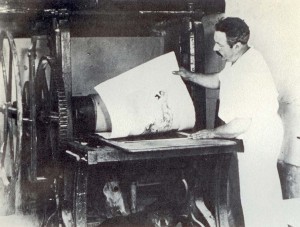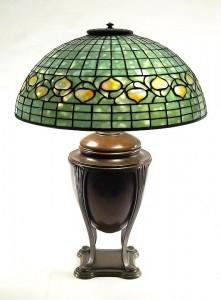
An authentic Tiffany Acorn lamp, similar to the reproduction I purchased
In the 1970s, I thought I had made friends with an auctioneer named Jerry Schuster. He had an auction house in New Windsor, NY, about an hour north of NYC. I visited him one day while driving past. He had what he said was a Tiffany Acorn lamp. In the years since my first signed lamp purchase, I was becoming an expert in Handel reverse-painted lamps. There were no Handel reverse-painted reproductions on the market, so getting a good education wasn’t that difficult. I had never purchased any leaded lamps because there were reproductions around and I couldn’t tell the difference. Jerry didn’t have the best reputation, so I asked him if he would guarantee the authenticity of the lamp. I remember what he said almost verbatim. “I don’t guarantee anything, but I guarantee this lamp to you.” So I paid him a fortune for the lamp, about $3,000.
I took the lamp home and made some calls to collectors and dealers, including Alice Osofsky, an old-time dealer. She came to my house with a friend, and after examining the lamp, told me the lamp was a reproduction. My heart sank, so I called other dealers and they all agreed – the lamp was a fake.
No problem! I’ll call Jerry and he’ll give me my money back because he guaranteed it to me. “Jerry, the lamp is a reproduction, so I’m returning it.” “What are you talking about, Phil? If you have an expert to say it’s a reproduction, I have another one to say it’s not.” Again, this is almost verbatim. So this was one costly lesson. I sold it to another dealer, telling him the truth that I was told it was a reproduction. I took a big loss on the lamp, but it was gone and at least I recovered some of my money.
Fast forward a few years to 1979. I was sitting in my car on Canal Street in Manhattan, listening to the news, when the announcer told of the arrest of an auctioneer from Westchester County, named Jerry Schuster. I started whooping and hollering and jumping up and down in my car. Sorry, folks, but I’m not a saint. I was as happy as a clam. In 1980, a Federal District Court in Manhattan found Schuster guilty of knowingly selling paintings with forged signatures of famous artists and reproducing Tiffany-style lamps with unauthorized Tiffany imprints. Jerry was sentenced to a year and a day in prison, plus four years probation and a $10,000 fine. Nice guy that he was, he was re-arrested and in 1990, he was convicted of conspiracy, bank fraud, mail fraud, and wire fraud in connection with an insurance scam involving a damaged painting. He was sentenced to three years in prison and prohibited from working in the art, antiques or auction field for three years after his release. You’d think he would have learned his lesson, but again in 2000, his art gallery agreed to refund an estimated $111,000 to 18 defrauded customers, and pay $45,000 to the Attorney General’s office for their legal costs. (Thanks to the International Foundation for Art Research for the exact information above.)
And now I have my own blog and I can tell Jerry and the rest of the world, it couldn’t have happened to a nicer guy!
Please send me your suggestions or questions about art glass, lamps, Louis Icart, shows, auctions, etc. If it’s interesting, I’ll answer your question in a future blog entry.
Call or write and let me know what you would like to buy, sell, or trade. philchasen@gmail or 516-922-2090. And please visit my website. chasenantiques.com
